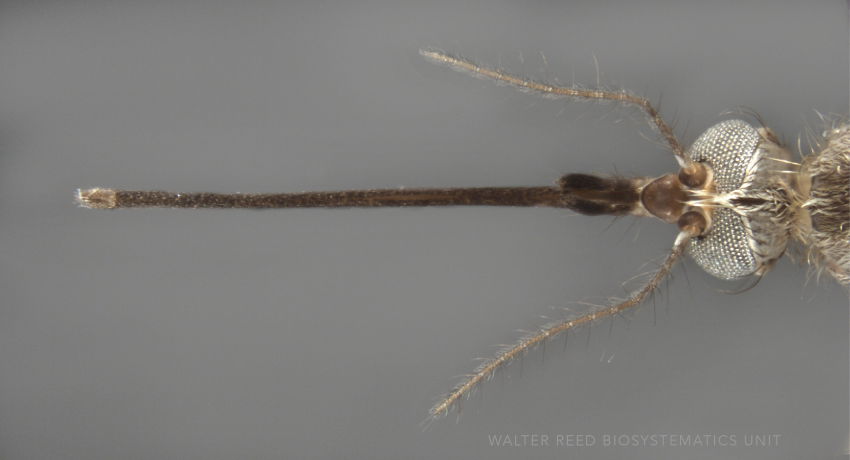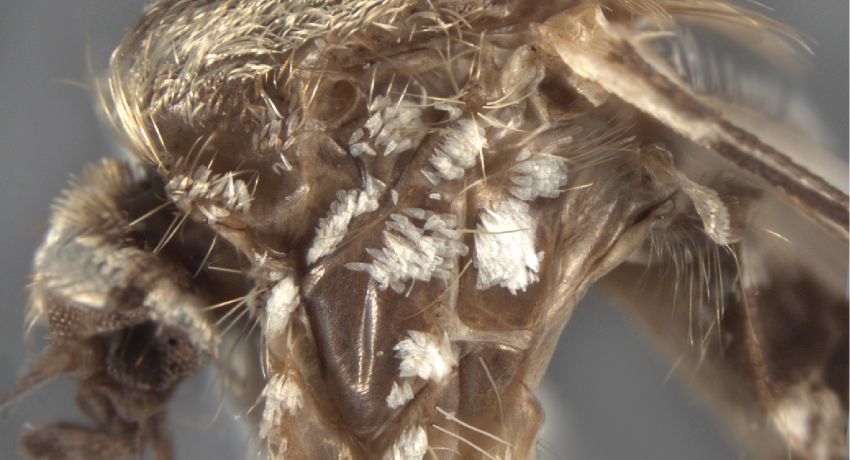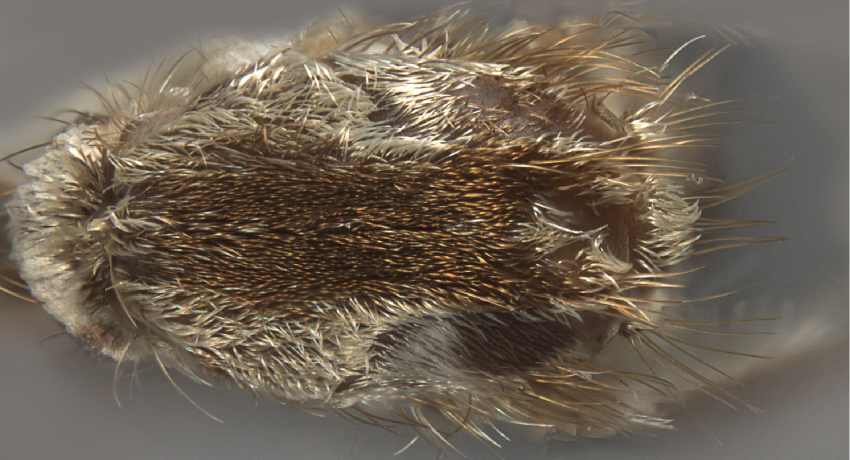NEARCTIC & NEOTROPICAL REGIONS
[Europe invasive]
Etymology: dark feeler (L); palpus
Aedes atropalpus belongs to the small subgenus Georgecraigius that comprises only three species–Ae. atropalpus and Ae. epaticus (in the Atropalpus Group) and Ae. fluviatilis (Fluviatilis Group). It has been proposed that Aedes atropalpus may hybridize with Ae. epaticus, but evidence for this is not convincing. The native range of Ae. atropalpus is the eastern United States and Canada. However the species has expanded its range into Central America, and most recently has invaded Europe. It became established in Italy in 1996, and was detected and eliminated from France in 2003 and 2005, Switzerland in 2008, and the Netherlands in 2008 and 2010.
Type locality: Plummers Island, Montgomery County, Maryland, United States
Type depository: U.S. National Museum, Washington, D.C., United States (USNM)
DIAGNOSTIC CHARACTERS (Click photos to view; mouse over and click large photo to zoom in.)
ADULT (illustrated): Head: Clypeus without scales. Thorax: Paratergite bare; postspiracular scales present; C-III with scales on lateral surface; scutum with posterior dorsocentral setae and broad lateral pale-scaled area reaching dorsocentral area, scales pale yellowish to pale golden with background scales mostly dark, bronze-colored; scutellum dark-scaled, without broad white scales on lobes; posterior scutal fossa without setae. Legs: Ta-III1–4 with basal and apical rings; Ta-III5 white-scaled.
LARVA (not illustrated): Head: Anterior portion of head and antenna distinctly more pigmented than posteriorly. Abdominal segments: Seta 6-III,IV usually 4,5 branched. Terminal segments: Base of siphon irregularly sclerotized with an extensive basal membranous-appearing area ventrally between rows of pecten spines; comb scales numerous, usually 34–62, rounded with distinct fringe; pecten spines widely spaced distally; seta 4-X on grid, without precratal setae.
TAXONOMIC KEYS
Carpenter & LaCasse 1955
Dodge 1966
Bohart & Washino 1978
Darsie & Ward 2005
Harrison et al. 2016
Exemplar DNA sequences
Ae. atropalpus COI: JF868951, MG242470; KM457565-67 (as Ochlerotatus atropalpus).
BIONOMICS
Immatures
Their preferred immature habitats are rock holes or rock pools associated with streams and rivers, although it has also been reported occupying tree holes, small ground pools and from Agave plant axils. It can be a common and conspicuous mosquito along rocky streams and rivers like the Potomac, just to the west of Washington, D.C., United States, much to the annoyance of fishermen. Sometime after 1972, the species adapted to immature development in tires, causing a rapid expansion of range and apparent abundance.
Adults
Day-biting Ae. atropalpus feed avidly on man, especially close to their immature habitats. Female Ae. atropalpus are autogenous, depositing their first batch of eggs without requiring a blood meal, and can produce several egg batches per year in warmer climates. Eggs of Aedes atropalpus are laid on the walls of containers, where they can also Aedes atropalpus overwinter. Eggs are stimulated to hatch by water inundation. SLEV and LACV can be transmitted transovarially in this species in the laboratory.
DISTRIBUTION NOTES
Canada, Costa Rica, El Salvador, Italy, Mexico, Netherlands, Nicaragua, Paraguay, United States (continental), Venezuela.

WRBU VECTOR HAZARD REPORTS
VHR: Medically Important Mosquitoes of EUCOM
View other WRBU Vector Hazard Reports
Available GIS Models:
None
IMPORTANT REFERENCES (full citations below)
Coquillett 1902d: 292 (M, F; Culex)
Howard et al. 1913 (1912) (E*)
Howard et al. 1917 (E)
Trembley 1947: 244 (laboratory bionomics)
Ross 1947 (F*)
Darsie 1951: 15 (P*)
Yamaguti & LaCasse 1951d: 230 (M*, F*, L*)
Hedeen 1953: 1 (bionomics)
Carpenter & LaCasse 1955: 253 (M*, F*, L*; keys)
Craig 1956 (E*)
Stone & Knight 1956a: 215 (type information, lectotype designation)
Craig & Horsfall 1958 (E*)
Craig & Horsfall 1960 (E*)
Dodge 1966: 349 (1st instar L*; key)
Mohrig 1967 (F*)
Horsfall et al. 1970: 1710 (E*)
O'Meara & Craig 1970a: 476 (taxonomy, distribution)
Zavortink 1972: 102 (M*, F*, P*, L*; subgeneric transfer; taxonomy)
Brust 1974: 459 (E*; taxonomy)
Lunt 1977a: 470 (molecular taxonomy)
Bohart & Washino 1978: 42 (M, F, P, L; keys, taxonomy, bionomics, distribution)
Romi et al. 1997: 245 (distribution; Italy)
Juliano & Lounibos 2005 (bionomics; invasive)
Darsie & Ward 2005 (F*, L*; keys, distribution)
Reinert et al. 2006 (taxonomy, phylogeny; to Georgecraigius (Georgecraigius))
Reinert 2008a: Fig. 1 (F*)
Becker et al. 2012 (review, invasive)
Medlock et al. 2012 (bionomics, invasive review; Europe)
Scholte et al. 2012 (bionomics, review)
Wilkerson et al. 2015 (phylogeny; to Aedes (Georgecraigius))
Harrison et al. 2016 (F*, L*; keys, distribution)
Robert et al. 2019 (distribution, Euro-Mediterranean)
CURRENT SYNONYMS
None
CITED REFERENCES
Becker, N., Pluskota, B., Kaiser, A., & Schaffner, F. (2012). Exotic mosquitoes conquer the world. In Arthropods as vectors of emerging diseases (pp. 31–60). Springer, Berlin, Heidelberg.
Bohart, R.M. & Washino, R.K. (1978). Mosquitoes of California (3rd ed.). Berkeley, CA: University of California, Agriculture and Natural Resources.
Brust, R.A. (1974). Reproductive isolation within the Aedes atropalpus group, and description of eggs. Journal of Medical Entomology, 11(4), 459–466.
Carpenter, S.J., & LaCasse, W.J. (1955). Mosquitoes of North America (North of Mexico). Berkeley, Los Angeles: University of California Press.
Coquillett, D.W. (1902d). Three new species of Culex. Canadian Entomologist, 34, 292–293.
Craig Jr., G.B. (1956). Classification of eggs of nearctic Aedinae mosquitoes (Diptera: Culicidae). Dissertation Abstract (5).
Craig Jr., G.B., & Horsfall, W.R. (1958). Taxonomic and ecological significance of eggs of aedine mosquitoes. Proceeding of the Tenth International Congress of Entomology, 3, 853–857.
Craig Jr., G.B., & Horsfall, W.R. (1960). Eggs of floodwater mosquitoes. VII. Species of Aedes common in the Southeastern United States (Diptera: Culicidae). Annals of the Entomological Society of America, 53(1), 11–18.
Darsie, R.F., Jr. (1951). Pupae of the culicine mosquitoes of the northeastern United States (Diptera, Culicidae, Culicini). Ithaca, NY: Cornell University Agricultural Experiment Station Memoir 304.
Darsie, R.F., Jr., & Ward, R.A. (2005). Identification and geographical distribution of the mosquitoes of North America, north of Mexico. Gainesville, FL: University Press of Florida.
Dodge, H. R. (1966). Studies on mosquito larvae II. The first-stage larvae of North American Culicidae and of world Anophelinae. Canadian Entomologist, 98, 337–393.
Harrison, B.A., Byrd, B.D., Sither, C.B., & Whitt, P.B. (2016). The mosquitoes of the Mid-Atlantic Region: an identification guide (Vol. 1). Madison Heights, MI: Publishing XPress.
Hedeen, R.A. (1953). The biology of the mosquito Aedes atropalpus Coquillett. Journal of the Kansas Entomological Society, 26, 1–10.
Horsfall, W.R., Voorhees, F.R., & Cupp, E.W. (1970). Eggs of floodwater mosquitoes. XIII. Chorionic sculpturing. Annals of the Entomological Society of America, 63, 1709–1716.
Howard, L.O., Dyar, H.G., & Knab, F. (1913). The mosquitoes of North and Central America and the West Indies. (Vol. II) (1912). Washington, D.C.: Carnegie Institution of Washington.
Howard, L.O., Dyar, H.G., & Knab, F. (1917). The mosquitoes of North and Central America and the West Indies. Systematic description. Part II. Carnegie Institute of Washington.
Juliano, S.A., & Lounibos, L.P. (2005). Ecology of invasive mosquitoes: Effects on resident species and on human health. Ecology Letters, 8(5), 558–574.
Lunt, S.R. (1977a). Protein band studies of the subspecies in the Aedes atropalpus group. Mosquito News, 37(3), 470–473.
Medlock, J.M., Hansford, K.M., Schaffner, F., Versteirt, V., Hendrickx, G., Zeller, H., & Van Bortel, W. (2012). A review of the invasive mosquitoes in Europe: Ecology, public health risks, and control options. Vector-Borne and Zoonotic Diseases, 12(6), 1–13.
Mohrig, W. (1967). Die taxonomische Bedeutung der Struktur weiblicher Genitalien im Culiciden- Tribus Aedini. Angewandte Parasitologie, 8, 67–100.
O'Meara, G.F., & Craig, Jr., G.B. (1970a). A new subspecies of Aedes atropalpus (Coquillett) from southwestern United States (Diptera: Culicidae). Proceedings of the Entomological Society of Washington, 72, 475–479.
Reinert, J.F., Harbach, R.E., & Kitching, I.J. (2006). Phylogeny and classification of Finlaya and allied taxa (Diptera: Culicidae: Aedini) based on morphological data from all life stages. Zoological Journal of the Linnaean Society, 148(1), 1–101.
Robert, V., Günay, F., Le Goff, G., Boussès, P., Sulesco, T., Khalin, A., Medlock, J.M., Kampen, H., Petrić, D. & F. Schaffner. (2019). Distribution chart for Euro-Mediterranean mosquitoes (western Palaearctic region). Journal of the European Mosquito Control Association, 37, 1–28.
Romi, R., Pontuale, G., & Sabatinelli, G. (1997). Identification of the immature stages of the Italian mosquitoes (Diptera, Culicidae). Le zanzare italiane: generalita' e identificazione degli stadi preimaginali (Diptera, Culicidae). Fragmenta Entomologica, 141(Supplemento).
Ross, H.H. (1947). The mosquitoes of Illinois (Diptera, Culicidae). Bulletin of the Illinois Natural History Survey, 24(1), 1–96.
Scholte, E.J., Dik, M., Ibanez Justicia, A., Den Hartog, W., Schoelitsz, B., Brooks, M., . . . Steeghs, M. (2012). Findings and control of two invasive exotic mosquito species, Aedes albopictus and Ae. atropalpus (Diptera: Culicidae) in the Netherlands, 2011. European Mosquito Bulletin, 30, 1–14.
Stone, A., & Knight, K.L. (1956a). Type specimens of mosquitoes in the United States National Museum. II. The genus Aedes (Diptera, Culicidae). Journal of the Washington Academy of Sciences, 46(7), 213–228.
Trembley, H.L. (1947). Biological characteristics of laboratory-reared Aedes atropalpus. Journal of Economic Entomology, 40, 244–250.
Wilkerson, R.C., Linton, Y.-M., Fonseca, D., Schultz, T., Price, D., & Strickman, D. (2015). Making mosquito taxonomy useful: A stable classification of tribe Aedini that balances utility with current knowledge of evolutionary relationships. PLoS ONE, 10(7), e0133602.
Yamaguti, S., & LaCasse, W.J. (1951d). Mosquito fauna of North America Part V – Genus Aedes. Office of the Surgeon, Headquarters, 8th Army, APO 343. United States. Office of the Surgeon-General. 207th Malaria Survey Detachment.
Zavortink, T.J. (1972). Mosquito studies (Diptera, Culicidae) XXVIII. The new world species formerly placed in Aedes (Finlaya). Contributions of the American Entomological Institute, 8(3), 1–206.
CITE THIS PAGE
Walter Reed Biosystematics Unit (Year). Aedes atropalpus species page. Walter Reed Biosystematics Unit Website, http://wrbu.si.edu/vectorspecies/mosquitoes/atropalpus, accessed on [date (e.g. 03 February 2020) when you last viewed the site].










































































































































































